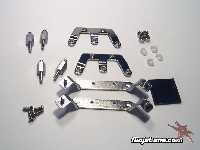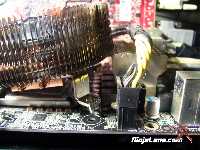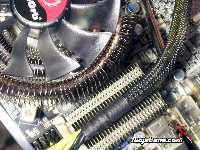After careful consideration I have decided to transfer all hardware review activities to a new domain. I purchased Hardwareasylum.com in 2012 and have been working hard to build a new and improved Ninjalane on that domain. If you are reading this you have reached one of the archived articles, news, projects and/or reviews that were left behind during the site migration.
Please update your bookmarks and be sure to visit the new and improved Ninjalane at Hardwareasylum.com
Thermaltake MeOrb Heatsink Review
Author: Jim Manis
Published: Tuesday, August 18, 2009
Installation
Inside the package you wil find the hardware needed to allow mounting for socket 775 Intel boards as well as AM2/AM2+/939 and 475 sockets. We will just be testing on 775 socket configuration.
The hardware is well made and designed to be installed very easily, however mounting hardware required that the motherboard be removed to properly install the heatsink.
The hardware is well made and designed to be installed very easily, however mounting hardware required that the motherboard be removed to properly install the heatsink.
During the tests we discovered clearance issues on our test rig. By switching to several other DFI motherboards we found basically the same issue, the fins were just to big and encroached into the Intel specified "no build zone". It is common knowledge that not every aftermarket heatsink will fit every motherboard. The best you can do is try different options until you get something to work.
In our testing we tried rotating the MeOrb 90 degrees to clear the PWM cooler which in turn would no longer clear the stock Northbridge heatsink. Turning the heatsink back would clear the Northbridge cooler but would not clear the PWM. In the end we were able to bend some of the radiator fins enough to clear the onboard heatsinks and complete our testing.
In our testing we tried rotating the MeOrb 90 degrees to clear the PWM cooler which in turn would no longer clear the stock Northbridge heatsink. Turning the heatsink back would clear the Northbridge cooler but would not clear the PWM. In the end we were able to bend some of the radiator fins enough to clear the onboard heatsinks and complete our testing.
Install Notes
The fitment issue was unexpected and after working with the cooler it was decided that most boards should be able to accommodate the cooler without the clearance issue we discovered. Our test motherboard is the DFI LanParty P45 T2RS. Give that this board is a MicroATX design and currently being used in a HTPC it seemed perfect for a low profile heatsink test. The issue here is that DFI chose to use large heatsinks to help passively cool the motherboard components which were likely the main issue here.





